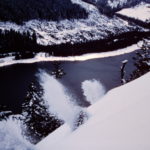Northwest Avalanche Center’s 1970s origins
Feb 3, 2021, 11:10 AM | Updated: Feb 8, 2021, 10:50 am
Winter means snowshoeing and skiing in the scenic Cascade backcountry. It also means a team of meteorologists and other experts keeping an eye on weather and mountain snow conditions, and keeping the public updated about the latest forecasts and potential hazard of deadly avalanches.
The Northwest Avalanche Center – or NWAC, pronounced “N-whack” – is a forecasting and public education partnership between the National Weather Service, National Forest Service, Washington State Parks, Washington State Department of Transportation, and the outdoor recreation industry.
The NWAC is a decently sized operation nowadays, with 15 staff members – including forecasters stationed at Forest Service facilities along the Cascades – and a central office in North Bend.
The organization traces its roots back to the early 1970s, in what began as a much more modest and even spartan operation.
Individual forest rangers and ski area operators in the Cascades had been dealing with mountain weather for decades, with avalanches a palpable and often deadly threat to individuals on foot or skis, or riding over the train tracks and highways that began to be built through the mountains in the 19th century.
An accomplished author and snow scientist working at the University of Washington named Ed LaChapelle was engaged to do some avalanche research for the old Washington State Highway Department. This work led to the hiring of two young scientists for what was going to be a short-term research project, and that both men hoped would mean a lot of chances to spend time in the mountains and to ski.
One of the researchers was Mark Moore – who would go on to run the Northwest Avalanche Center for more than 30 years. The other was future KING 5 meteorologist Rich Marriott.
“It actually came about because in the early 70s, backcountry usage was starting to pick up,” Marriott told KIRO Radio. “But more importantly, I-90 through Snoqualmie Pass had been completed. There’d been some avalanche problems with the construction of the highway itself. In fact, Franklin Falls Bridge actually was partially damaged by an avalanche that came down and hit it while they were doing construction, and they had to build barriers uphill to protect that bridge. They also had a couple of accidents that involved private passenger cars, and they’d also just opened up the North Cascades Highway, and DOT wanted to be able to keep things open and keep them safe, and needed more information to be able to even know when to do avalanche control at that point.”
In the early days, the Northwest Avalanche Center was a bit of a shoestring operation. It was the second such project of its kind in the United States, with only the Colorado Avalanche Information Center – Colorado has more deaths from avalanches than any other state – predating NWAC by just a few years.
Even with the coordination that Marriott and Moore brought to the existing individuals and groups already collecting mountain weather information, both saw a need for more real-time data.
“Our two goals as part of the project was to figure out what information we needed, and then set up the network to collect that information,” Marriott said.
The data was key, Marriott says.
“To really forecast the avalanche dangers, as opposed to just evaluating what they are right now, you have to look at the snowpack,” Marriott said. You have to “look at the layering in the snowpack – basically, look for weak layers that could be easily triggered – and then you have to overlay that with an accurate mountain weather forecast of how that snowpack is going to evolve to know whether the danger is going to decrease or increase.”
This meant customizing and personally installing automated weather instruments at key places in the Cascades, such as on a ridge overlooking Old Faithful near Stevens Pass, and near Chairlift #5 at the Stevens Pass Ski Area. It also meant getting creative about retrieving the data remotely in what was a decidedly more analog era.
“We had to lease a [phone] line between Seattle and Stevens Pass,” Moore said. “We had our own line for feeding information all the time,” and an early type of modem for decoding data sent from the chairlift, by phone line, to the NWAC office.
This inventiveness came in handy in building a network of remote weather stations, especially when an instrument needed unanticipated repairs in the field.
“In the early days when we had instrumentation go wrong,” Moore said, “we would take Big Red chewing gum, and we’d use a wad of that to stick a tipping-bucket precipitation gauge back on the fulcrum” – in order to keep accurately measuring snowfall, as water, melted by a layer of heated oil – “and it would work the rest of the year.”
“We [also] had an anemometer that had three cups, and we lost one of the cups,” Moore said. “So we cut a beer can in half, and put the beer can on for one of the cups.”
“And it worked,” Moore added.
And what about that office where Stevens Pass and other data was collected? When the two scientists weren’t in the field analyzing snow or performing rogue repairs on weather instruments, headquarters for the Northwest Avalanche Center was a couple of desks at the old National Weather Service offices on Lake Union.
That didn’t go so well at first.
“The forecasters in the Weather Service did not like us,” Marriott said. “I mean, we were these hotshots from the University of Washington, and we’re going to come and take their jobs.”
Many of those older forecasters likely had careers that stretched back to the Signal Corps in World War II, or at least to the Weather Service’s earlier incarnation as the U.S. Weather Bureau.
“Keep in mind, this was the mid-70s,” Marriott continued, “and both Mark and I look like we just came out of the backcountry after two years. We have huge hair and huge beards. The first couple of years there, very few of the forecasters would even speak to us. They wanted to have us deloused.”
But Moore says that he and Marriott – or maybe it was the data they were collecting and eagerly sharing – eventually did win over even the crustiest of the crusty old National Weather Service guys.
“Fortunately, we had a mentor within the National Weather Service, Frank (Bud) Reanier, who had been the Deputy Meteorologist-in-Charge of the National Weather Service in Seattle,” Moore said. “He fought for us to be accepted there and, grudgingly, even the old-time forecasters accepted what we were doing because we were helping them out, because they didn’t have a lot of information at time about what was happening in the mountains.”
Rich Marriott, Mark Moore, and current NWAC Executive Director (of the nonprofit arm of the organization) Scott Schell, all emphasize that the whole point of studying avalanches, and preparing forecasts, and educating the public is about saving lives. In the day-to-day, this work often translates into helping an agency such as the Washington State Department of Transportation (WSDOT) manage equipment for snow removal or avalanche control, and make potentially costly decisions about staffing levels in anticipation of a major event.
Marriott says in the early days, this responsibility could be very humbling.
“There was this big storm headed toward us and we were really starting to understand some of the microclimates of the Cascades and such,” Marriott said. “I was forecasting, and DOT was taking the information and using it for the maintenance crews. And it looks like this big storm was coming in and they have plows on standby. And, I mean, they were ready for this big dump.”
What happened on that long-ago potentially snowy day in the mountains?
“I think they got three flakes,” Marriott said. “I was humiliated and I thought that I should just quit.”
The WSDOT’s modern avalanche control – forecasting or detecting dangerous conditions, temporarily closing highways, intentionally triggering avalanches with small explosive devices, and then clearing away the snow – is fairly routine over the Cascades nowadays. Marriott and Moore were in on some fairly dramatic experiments 40 years ago in a search for alternatives to military explosives.
“The military was getting less happy about giving artillery to civilians,” Marriott said, laughing and recalling a surplus U.S. Army tank that was used to fire at the slopes to trigger avalanches on Stevens Pass many years ago.
Non-military alternatives included such things as giant inflatable rubber bags under the snow that could be inflated to trigger avalanches, and blasts of ignited oxy-acetylene delivered by pipe to chronic avalanche spots.
Along with avalanche control, forecasting methods have improved over the decades, too. Marriott, who left the NWAC for KING TV in 1987, says there are always more opportunities for public education about avalanche danger to ultimately fully empower individuals to make good choices when faced with potentially dangerous conditions in the backcountry.
“Now you can define the large-scale avalanche conditions, but getting it down into detail really depends on where the person travels,” Marriott said. “And you see this lots of times in accidents where people ski a slope, … and there’ll be no problems. And suddenly, someone skis in a different spot and it triggers.”
That’s where the individual – and his or her knowledge – is most critical, Marriott says.
“You have these small-scale variations of stability on snow slopes,” Marriott said. “So it’s really important for people to be educated about avalanche danger and route-finding, and being able to recognize when the conditions are such that you really don’t want to take a chance.”
The best resource for becoming educated about avalanche danger is the Northwest Avalanche Center, which has moved the hundreds of education programs it gives in a typical year online because of the pandemic. Outdoor recreation in Washington, which was already a growth industry before the COVID-19 pandemic, has been booming over the past year.
Washington is the third-most dangerous state when it comes to avalanche deaths, and NWAC director Scott Schell says the number of avalanche deaths each year in the state has been pretty flat for the past decade – an average of three a year. Schell says that while any death is a tragedy, the fact the number remains flat – as the total number of skiers and showshoers heading into the backcountry has increased something like ten-fold – should be considered a success.
The NWAC, which is one of the best examples of a successful multi-agency partnership in the state, has a nonprofit arm that funds its forecasting activities, and that depends on private tax-deductible donations for about a third of its annual budget.
Schell says the NWAC raises a big chunk of this support using a method based on certain media outlets that have become well-known – infamous? – for things like pledge drives and tote bags.
“The ‘individual giving’ fundraising model that we use is basically the public radio model,” Schell said. “We have a service that benefits all and it’s free to all, and we don’t hide any of the forecasting products, or safety videos, or any of that behind a pay wall. Anyone can come in and use it.”
Schell points out that they even have hats and sweatshirts – replete with the NWAC logo – that donors receive as premium gifts.
But maybe they should consider offering a tote bag, too. I’d suggest a waterproof one, bearing a picture of NWAC co-founders Rich Marriott and Mark Moore in all their 1970s bearded glory.
You can hear Feliks every Wednesday and Friday morning on Seattle’s Morning News and read more from him here. If you have a story idea, please email Feliks here.

























